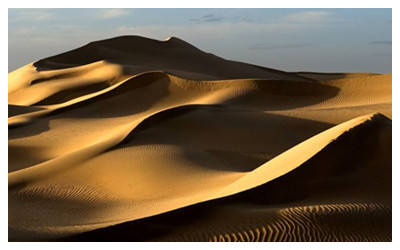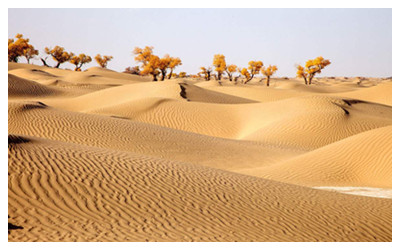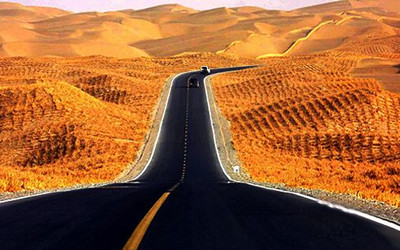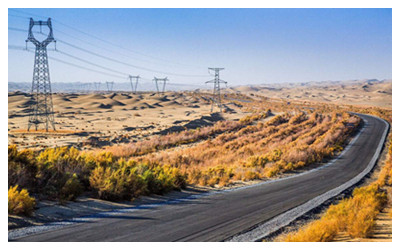Skype: neodalle-travel
Tel: +86 135 7447 2266
E-mail: sales@zhangjiajieholiday.com
 million years older than previously thought. It is as wide as the sea stretches boundlessly. The total area of this China desert reaches up to 330,000 square kilometers with the length of more than 1,000 kilometer from east to west and over 400 kilometers wide from south to north.Taklimakan Desert is really an ideal place for your undiscovered China tour with the lead of China Guide. Taklimakan Desert, named Takelamagan Desert as well, is ranked as the largest moving desert in China.
million years older than previously thought. It is as wide as the sea stretches boundlessly. The total area of this China desert reaches up to 330,000 square kilometers with the length of more than 1,000 kilometer from east to west and over 400 kilometers wide from south to north.Taklimakan Desert is really an ideal place for your undiscovered China tour with the lead of China Guide. Taklimakan Desert, named Takelamagan Desert as well, is ranked as the largest moving desert in China.
The boundless sea of sand of this China desert is considered as the 'Sea of Death' and 'the Place that nobody can leave after Entry'. However, Taklimakan Desert is accounted as the old house in Mongolian language. The reason is that it used to be a beautiful oasis with countless brilliant civilization instead of a desert.
 It is the Qomolangma among this China desert- Taklimakan Desert. The height difference between the mountain and this desert in China is more than 500 meters. It is different from other deserts in that there are more than 140 lakes in the Taklimakan Desert. Around this China desert, the birds play with each other and the lake and the mountain are well integrated, which make the visitors relax and enjoy themselves freely.
It is the Qomolangma among this China desert- Taklimakan Desert. The height difference between the mountain and this desert in China is more than 500 meters. It is different from other deserts in that there are more than 140 lakes in the Taklimakan Desert. Around this China desert, the birds play with each other and the lake and the mountain are well integrated, which make the visitors relax and enjoy themselves freely.
It is an original desert in China as well as a natural plant garden. Besides, it is a very active China desert. More than 300 kinds of plants grow here, and the first level national preserved animals--Asiatic wild ass, and bores, Mongolian gazelles, wolves, foxes and other animals also treat the Taklimakan Desert as their home. Manasi Lake, which is dried for half century has been alive now.
Taklimakan Desert in China is the largest sound desert sea as well as the highest China desert. The sand dunes are scattering. The famous Yinken sound sand is facing the mountains, like a crescent moon. The sand will sing when they are impacted, so people walk. But when people stop, the sand keeps quiet. Lucky enough, you will see the famous “light of God”.
 Taklimakan Desert is the most mysterious among all of the deserts in China, being attractive and dangerous. It is a place to make inquiries to life, and its name means that you will never want to go out if you come.
Taklimakan Desert is the most mysterious among all of the deserts in China, being attractive and dangerous. It is a place to make inquiries to life, and its name means that you will never want to go out if you come.
In 1970’ and 1980’, mummies were found in this dangerous China desert Taklimakan. The highest temperature there reaches 67.2 degree, and the temperature of this desert in China varies greatly between day and night, about 40 degree. It is the second largest quick desert in the world.
It is the fastest quick desert in china, composed by quick sand dunes. The sand peaks are magnificent and sands are smooth with golden colors.
Diaopuoliang is the typical scenery of the Takelamagan Desert, which is 39 meters high. Its changeable appearance and different image has brought many unique types of scenery for tourists. Therefore, Takelamagan Desert in China will leave an impressive memory to its travelers.
Moreover, Takelamagan Desert in China is also a place where the famous Silk Road goes through the way. Being a lengthy road passing through central Asia, Silk Road was officially recorded as early as 1st BC in Han Dynasty (206 BC - 220 AD). Over 70,000 kilometers (43,496 miles) long road connected ancient Chinese civilization with ancient Greek, ancient Babylon as well as ancient Indian culture together.
 In the following centuries, great civilizations clustered and thrived in the China desert-- Taklimakan Desert. A lot of precious historic relics were excavated here just like portrait of winged angel, Chinese brocade, Roman column, Indian Buddha statue and so forth. The technique of Chinese silkworm-raising, powder, paper-making and silk were spread to Central Asia and Rome.
In the following centuries, great civilizations clustered and thrived in the China desert-- Taklimakan Desert. A lot of precious historic relics were excavated here just like portrait of winged angel, Chinese brocade, Roman column, Indian Buddha statue and so forth. The technique of Chinese silkworm-raising, powder, paper-making and silk were spread to Central Asia and Rome.
Meanwhile, Islam, astronomy, maths and Nestorianism were introduced to China through this China desert. Silk Road rewrote the history of the world, while Taklimakan Desert was the very witness of this great reform.
According to the historical records, the 36 west countries once prospered in the area of desert in China. They were like the pearls scattering in the Taklimakan Desert. However, during the baptism of thousands of years, the brilliance of Taklimakan decayed as time goes by--the desert took the oases mercilessly. The past boom was buried in the endless sand dunes in this great China desert.
In A.D 400, explorer Fa Xian described the China desert Taklimakan by saying, "In this desert there areas great many evil spirits and also hot winds; those who encounter them perish to a man. There are neither birds above nor beasts below. Gazing on all sides as far as the eye can reach in order to mark track, no guidance is to be obtained save from the rotting bones of dead men, which point the way".
Through analysis of the heavy minerals in the sands of the Taklimakan which is the desert in China, Zhu (1984) determined that much of the desert sand is a product of weathering of the bedrock from the bordering mountains. These materials were transported into the basin by water and deposited in floodplains and river beds. He associates the average size of the sands in this China desert with the grain size of the underlying deposits, and notes that wind presently dominates the activity of the Taklimakan desert. Zhu (1984) discusses two dominant wind regimes of this desert in China from the satellite photos. Northeasterly winds dominate much of the desert, but winds from the northwest dominate the western Taklimakan desert. These two wind systems meet in the central-west part of the desert, resulting in a complex dune alignment.
Tour with Taklimaken Dsert
Since Desert tour is a kind of exploration in China for most visitors, we cannot offer a tour to desert in China so far. We need to gurantee the safty for every visitors to China. However, we could arrange some open and safe attractions in desert for your visiting. You could take Dunhuang Day Tour to discover Mogao Caves, Crescent Lake and Echoing Sand Mountain or 3 Day Mogao Grottoes and Crescent Lake Discovery. Moreover, if you are very interesting in China deserts, you could explore ancient Silk Road tour to experience the unique scenery in China.
 Ask Questions ?
Ask Questions ?